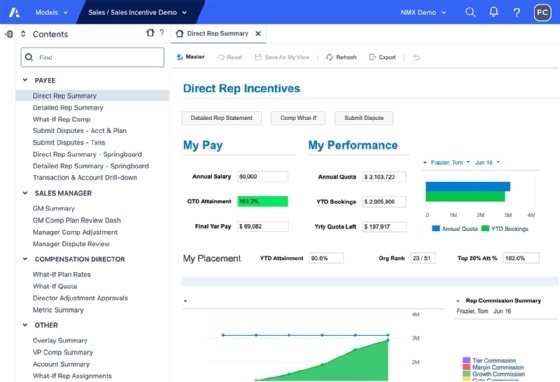Anaplan
What is Anaplan?
Anaplan is a web-based enterprise platform for business planning. It is also the name of the company that created the platform. Anaplan, whose name combines the words analysis and planning, is known for its in-memory database and calculation engine called Polaris.
Private equity firm Thoma Bravo bought Anaplan in June 2022. The $10.7 billion acquisition is expected to position Anaplan to be more competitive with other integrated business processing providers SAP and Oracle, as well as supply chain vendors like Kinaxis and Blue Yonder.
What is Anaplan used for?
Anaplan is used for corporate performance management (CPM), providing enterprise-grade collaborative business planning and business intelligence. By connecting planning and analytics, the software is often useful to improve operational performance.
Enterprise customers can upload data to the Anaplan cloud, letting the customer's business users organize and analyze disparate sets of enterprise data from finance, human resources, sales and other business units. Anaplan can be used for collaborative planning in the following business sectors:
- Sales. It can help with quota planning, sales forecasting and incentive compensation.
- Information technology (IT). It can be used for Agile implementation and planning, IT financial management and cost transparency, and facilities management.
- Finance. It can assist with CAPEX planning, financial consolidation, tax and treasury, and reporting and analysis.
- Supply chain management. It can be used for predictive analytics, trade promotions planning and distribution requirements planning.
Some companies that use Anaplan include Adobe, Bayer, Del Monte, Groupon and Unum.
UK-based South Central Ambulance Service used Anaplan to anticipate the number of emergency calls it expected to respond to in a given time and to determine how to allocate resources to responders. The service reported that the program helped the ambulance service achieve a 1.7% improvement in forecast accuracy.

Anaplan features
Anaplan modules for business analytics and planning process include tools for the following tasks:
- budgeting, planning and forecasting
- commission calculation
- demand planning
- financial consolidation
- profitability modeling
- project planning
- quota planning
- workforce planning
Anaplan is available in three main tiers.
- Basic. The basic tier includes essential capabilities for planning and modeling, such as interactive dashboard design, self-service data import and export, integration with Microsoft Office and CloudWorks, and Anaplan's cloud-based data integration and orchestration platform.
- Professional This tier adds enhanced capabilities, such as application lifecycle management, audit capabilities and DocuSign integration.
- Enterprise. The enterprise tier provides bring-your-own-key functionality, an additional workspace allowance and HyperCare advanced technical support service.
Professional tier customers can pay more for more enterprise-level technical support. Users of all tiers can pay additional fees for features like PlanIQ or HyperModeling as well. PlanIQ integrates Anaplan with machine learning and statistical algorithms to create business forecasts. HyperModeling aggregates large data sets for easier analysis.

Anaplan also introduced a new calculation engine called Anaplan Polaris in 2021.

Pros and cons of Anaplan
Anaplan was listed as a leader in Gartner's Magic Quadrant for Supply Chain Planning in 2022 and has been named a leader in the research group's Cloud Financial Planning and Analysis Magic Quadrant in the past. (Gartner stopped doing that Magic Quadrant in 2021.)
Anaplan is worth considering for some of the following reasons:
- Ease of use. Anaplan provides Excel-style functionality, so business users can use it to make data-driven decisions that would otherwise require a data scientist's skill set.
- Calculation engine. The platform includes a calculation and modeling engine that provides insights into past performance and models for the future. This information helps managers use business analytics to improve decision-making.
- Collaboration. The audit trail, model restore and selective user access features security for collaborative activities. Real-time collaboration features let teams work together remotely.
- Increased visibility. Data is represented down to the transactional level to enable more precise business decisions. Users can view relationships among multiple business plans to gauge the effects they have on one another. They can also view the metadata associated with each business plan.
- Dynamic integration. Dashboards enable users to aggregate and dynamically adjust multiple business plans.
Some of the drawbacks of using Anaplan include the following:
- Cookies. If a user's system does not accept cookies, they must reenable Anaplan's New Modeling Experience with each session.
- Support. Reviews of Anaplan cite that getting technical support for the platform can be a challenge.
- Imports. Large import and exports of data can slow down a model because they use a lot of resources.
Anaplan pricing
Anaplan license-based pricing depends on various factors, including a customer's user count, use plans and line of business. Pricing also depends on the number of workspace gigabytes the customer buys. Anaplan pricing can increase significantly as the tier and application complexity increase.
Anaplan does not offer a free plan or free trials but does offer product demos.
Anaplan vs. competitors
Anaplan is commonly compared to Excel. A long-term business case is necessary for businesses to switch from Excel to Anaplan.
Anaplan competitors vary based on the use. Gartner's Magic Quadrant report lists its competitors in the supply chain planning market as the following:
- Adexa
- Arkieva
- Blue Ridge
- Blue Yonder
- Coupa
- Dassault Systèmes
- E2open
- GainSystems
- Infor
- John Galt Solutions
- Kinaxis
- Logility
- Manhattan Associates
- O9 Solutions
- OMP
- Oracle
- Relex
- SAP
- Slimstock
- ToolsGroup
- Wolters Kluwer
For finance, Gartner Peer Insights lists the following products as alternatives ranked by recent buyers:
- IBM Planning Analytics
- Jedox EPM Software
- OneStream Platform
- Oracle Cloud EPM
- Planful Continuous Planning Platform
- Vena Solutions Budgeting, Planning & Forecasting
- Workday Adaptive Planning
Gartner used responses to product reviews to determine what factors customers used to compare competitors. They found that customers considering alternatives to Anaplan for sales and finance commonly compared integration and deployment features and support features.
Anaplan is one option for strategic enterprise budget planning. Digital transformation budgets have unique planning requirements. Learn some best practices for budget planning for digital transformation.







